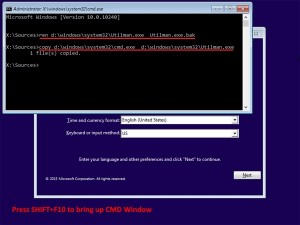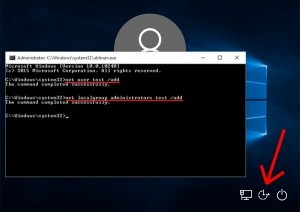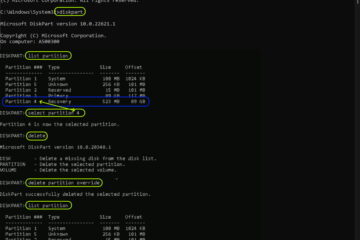If you forget your password on a Windows 10 PC and you cannot reset it using Microsoft’s typical processes, you can use this moderately straightforward routine.
The idea is to replace the EASE OF ACCESS program (designed to help handicapped people) with the CMD.EXE and then use that to create a new account.
The details are:
- Boot off a Windows 10 DVD (or USB)

- When the WINDOWS SETUP screen appears, press SHIFT+F10 to launch a CMD window
- Type ren d:\windows\system32\utilman.exe utilman.exe.bak and press the ENTER key
- Type copy d:\windows\system32\cmd.exe d:\windows\system32\utilman.exe and press the ENTER key
- Exit the Windows 10 setup (just power down)
- Boot normally to your hard drive
- At the Login Screen click the EASE OF ACCESS icon (beside the Power icon in the bottom right corner of the screen). Because of step
 4, this will launch a CMD window
4, this will launch a CMD window - Type net user test /add and press the ENTER key
- Type net localgroup administrators test /add and press the ENTER key
- Press ALT+F4 to close the CMD prompt
- Click the Power icon (bottom right corner of the screen) and select RESTART
- Sign in as TEST without a password
This created a local administrator named TEST. If you are on a domain use the username .\test and no password.
At this point you are a full local admin, so you can reset any local account password or access any file on the machine. If you logged in with a Microsoft Account or a Domain account, you will not be able to reset the users password but you will have full access to the files so you are not stuck.
I have followed this process on Windows 10 Pro 1511 on a Server 2012 R1 Functional Level Domain and it worked like a charm! I will test this on a Bitlocker / Sophos Encrypted disk next and report the findings.
A longer, prettier version of this is available at chntpw.com/reset-forgotten-windows-10-password .



11 Comments
denn · December 18, 2024 at 7:30 pm
i did this but now ease of access button does nothing when clicked on.
Ben · May 2, 2022 at 9:31 am
a quick question , after doing all these , I went back to change the utilman to cmd.exe , but there is no utilman anymore !!
I can see utilman1 ( which is the original utilman) but I do not find cmd or what we renamed it to utilman !!
how can I bring back cmd.exe
Ian Matthews · May 5, 2022 at 9:27 pm
Hi Ben;
You could try running SFC /SCANNOW (in a PowerShell) to see that will re-extract CMD.EXE for you.
Alternately you could install the new Windows Terminal (which will eventually replace both CMD and PowerShell) https://apps.microsoft.com/store/detail/windows-terminal/9N0DX20HK701?hl=en-ca&gl=CA
aron · March 13, 2019 at 9:49 am
DailyBuzzKill….nope, can confirm it works in 1809
Martin · October 17, 2018 at 10:03 am
Windows 10 Pro 1803. There is no Windows folder on D drive.
Ian Matthews · December 11, 2018 at 6:44 pm
D = your local disk in the example. If you do not see the WINDOWS directory, then you are in the wrong place so try a different drive letter until you find your local disk.
Dailybuzzkill · September 22, 2018 at 7:26 pm
This method no longer works. Must have been patched by MS.
Gerard Petrone · March 17, 2019 at 12:40 pm
It works. I just did it 5 min ago over the phone with my sister who needed to access my deceased brothers computer. d: is your optical drive. We are using the optical drive boot disk to interact with the hard drive. If something is wrong then your optical drive might be a different letter. Don’t think just follow the instructions exactly assuming your optical drive is d:
Gerard Petrone · March 17, 2019 at 12:44 pm
It works I just did it 5 min ago to access my deceased brothers computer. The d: is your optical drive. You are using the boot disk in the optical drive to interact with windows on the hard drive. If your optical drive is another letter which is rare but possible then simply change d: to whatever letter it really is.
S.Soo · January 13, 2017 at 3:47 am
After you’ve logged in again and reset the local user account passwords.
You need to repair the Ease of Access function, otherwise it will stay a backdoor into your Windows 10 PC.
Login as a local administrator
Open a command prompt.
Delete new utilman.exe
Type “del %systemroot%\system32\utilman.exe”
Copy original utilman.exe and rename.
Type “copy %systemroot%\system32\utilman.exe.bak %systemroot%\system32\utilman.exe”
Ease of access should now be restored.
You’ll still have the extra utilman.exe.bak file.
Which you’ll need to change it’s file permissions to delete.
Or keep it, it’s only 88KB
p.kavitha · October 25, 2016 at 3:18 am
Generate a new password